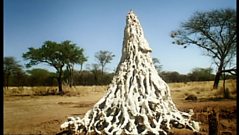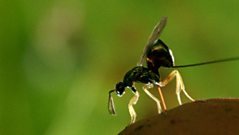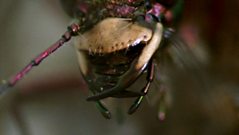Intimate Relations
Natural history series. David Attenborough looks at the complex alliances and partnerships tiny creatures form between each other and with plants.
Ever since they came onto land, the tiny creatures of the undergrowth have been forming alliances and partnerships with each other and with plants.
As David Attenborough says in his opening, many of these intimate relations are of a complexity that blows the mind. And while some of these relationships clearly benefit both partners, others most certainly do not.
Take the bot fly - a bruiser in the fly world. It uses smaller house flies as unwitting couriers to carry its eggs to cows where they hatch and bore into the cow's flesh. Or the tiny fairy wasp - 0.25mm long - that flies under water and lays its eggs inside water beetle eggs.
In the programme's final sequence we see how the caterpillar of the blue butterfly sneaks its way into an ants' nest by mimicking the smell of the ants' young. There it is protected and fed for almost two years. But a recently discovered wasp has an uncanny knack for pinpointing nests with caterpillars in. It breaks into the ants' nest using a collection of chemical tricks that any spy would love to get his hands on. One of these chemicals forces the ants to attack each other, giving the wasp time to lay its own egg into the caterpillar's body. When the wasp leaves and the nest returns to normal the ants feed the caterpillar as if nothing has happened, but when it pupates what comes out? Not a butterfly but a wasp. Mind-blowing indeed!
Last on
More episodes
Previous
Next
Clips
-
![]()
Insect skyscraper
Duration: 02:41
-
![]()
Galling attack
Duration: 01:31
-
![]()
Handy disguise
Duration: 03:19
-
![]()
Predator or prey?
Duration: 03:22
Credits
| Role | Contributor |
|---|---|
| Presenter | David Attenborough |
| Producer | Stephen Dunleavy |





